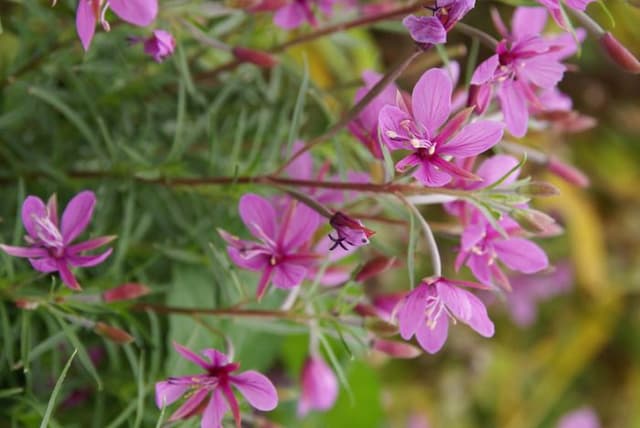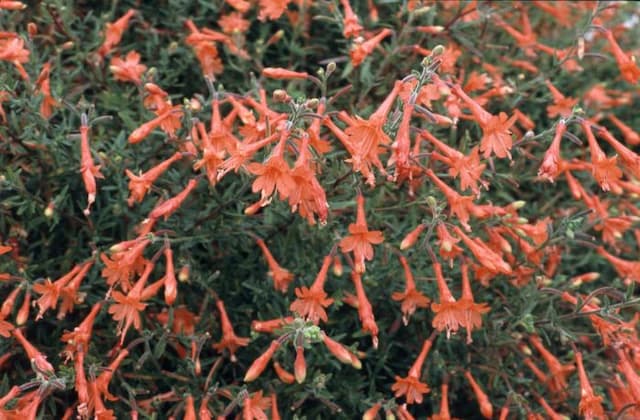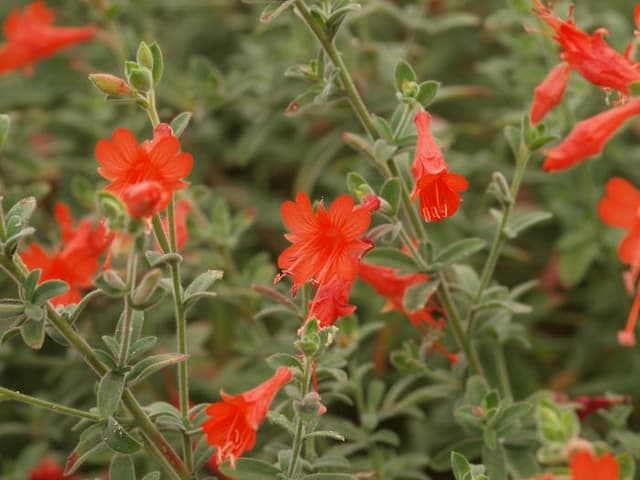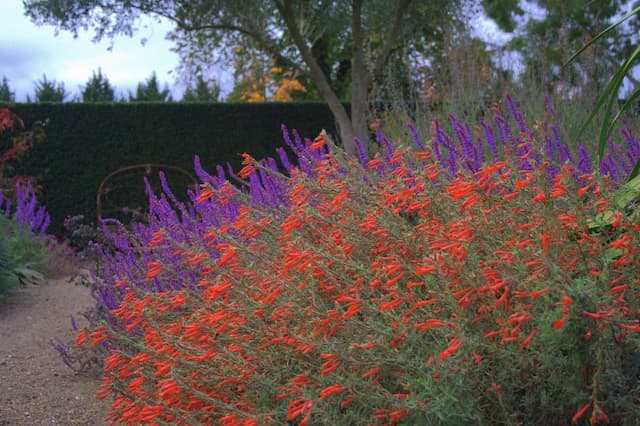Fuchsia Fuchsia 'Claudia' (d)

ABOUT
Fuchsia 'Claudia' is a vibrant plant known for its graceful, drooping flowers that present a striking two-toned color palette. The blossoms typically display a harmonious combination of purple and pink hues. The outer petals are usually a lighter shade, providing a delicate sheath around the bolder-colored inner petals. These inner petals often curl elegantly, poking through the paler outer ones, giving the blooms a layered, lantern-like appearance. The flowers dangle from slender stems, sometimes likened to dainty earrings, adding to the overall elegance of the plant. The foliage of Fuchsia 'Claudia' provides a lush backdrop to its lively flowers with deep green leaves that are slightly elongated, possessing a subtle sheen that captures light. The leaves cluster densely, creating a full, bushy silhouette that cradles and showcases the prominent floral display. The growth habit of the plant is typically trailing or bushy, making it a popular choice for hanging baskets or garden beds where it can either cascade or grow more upright supporting its pendulous blooms. It can thrive both outdoors and indoors, where the colorful blossoms can be admired up close. The vivid display of Fuchsia 'Claudia' is long-lasting, with the flowering season extending from spring through to fall, offering a generous period for the enjoyment of its ornamental features.
About this plant
 Names
NamesFamily
Onagraceae
Synonyms
Claudia Hardy Fuchsia, Lady’s Eardrop, Claudia Fuchsia
Common names
Fuchsia 'Claudia'
 Toxicity
ToxicityTo humans
Fuchsia plants, including 'Claudia', are generally regarded as non-toxic to humans. They do not contain known toxic compounds that would cause harm if ingested in small quantities. Accidental ingestion of fuchsia parts typically does not lead to symptoms of poisoning. However, ingesting large quantities of any non-food plant material can potentially cause a stomach upset or an allergic reaction in sensitive individuals.
To pets
Fuchsia plants, like 'Claudia', are not considered toxic to pets such as dogs and cats. They are generally safe and there is no widespread evidence of them causing poisoning in household pets. As with humans, ingestion of the plant may lead to mild gastrointestinal upset if consumed in large amounts. It is always best to discourage pets from eating plants, due to the potential for stomach upset and to avoid the rare possibility of a sensitive reaction.
 Characteristics
CharacteristicsLife cycle
Perennials
Foliage type
Deciduous
Color of leaves
Green
Flower color
Mixed
Height
2-4 feet (0.6-1.2 meters)
Spread
2-4 feet (0.6-1.2 meters)
Plant type
Shrub
Hardiness zones
6-11
Native area
Central and South America
Benefits
 General Benefits
General Benefits- Attractive Flowers: Fuchsia 'Claudia' produces beautiful teardrop-shaped blossoms that add a visual appeal to gardens and landscapes.
- Color Variety: The flowers of this fuchsia variety typically feature a blend of pinks, purples, and whites, offering a range of hues that can complement various garden color schemes.
- Pollinator Friendly: Fuchsias are known to attract hummingbirds and beneficial insects, which help pollinate other plants in the garden.
- Versatile Planting: Suitable for containers, hanging baskets, and borders, allowing for flexibility in garden design and space utilization.
- Shade Tolerance: This variety of fuchsia is capable of thriving in partial shade, making it ideal for brightening up less sunny areas of a garden.
- Long Blooming Season: Fuchsias have a long flowering period that usually lasts from spring to fall, providing prolonged enjoyment.
- Relatively Easy to Grow: With appropriate care regarding water and light requirements, Fuchsia 'Claudia' is relatively easy for both novice and experienced gardeners to cultivate.
 Medical Properties
Medical PropertiesThis plant is not used for medical purposes.
 Air-purifying Qualities
Air-purifying QualitiesThis plant is not specifically known for air purifying qualities.
 Other Uses
Other Uses- Fuchsia 'Claudia' can be used as a natural dye for fabrics, imparting a subtle pink or purplish color depending on the mordant used.
- The plant may serve as a learning tool for botany students who wish to study its unique floral structure and reproductive mechanisms.
- When dried, the blossoms of Fuchsia 'Claudia' can be used in potpourri mixes to add color and a mild floral fragrance.
- Fuchsia can be incorporated into creative landscaping designs as living curtains or privacy screens with its cascading growth habit.
- Bonsai enthusiasts might choose Fuchsia 'Claudia' for its interesting form and flowering habit, creating miniature artistic trees.
- The flowering plant can be used in crafting, such as pressed flower art, due to its distinctive and vivid blooms.
- Culinary enthusiasts might explore the edible flowers of Fuchsia 'Claudia' as a decorative and slightly acidic addition to desserts.
- In photography, the vibrant flowers of Fuchsia make for a stunning subject in macro photography, highlighting their intricate patterns and colors.
- Fuchsia 'Claudia' can act as a natural indicator for pH balance when used in science education; the flower color may vary with different soil pH levels.
- The plant can be part of sensory gardens designed for therapeutic purposes, offering visual stimulation with its bright flowers and soft textures.
Interesting Facts
 Feng Shui
Feng ShuiFuchsia is not used in Feng Shui practice.
 Zodiac Sign Compitability
Zodiac Sign CompitabilityFuchsia is not used in astrology practice.
 Plant Symbolism
Plant Symbolism- Gracefulness: The elegant drooping of fuchsia blossoms is often associated with grace and poise.
- Confiding Love: Fuchsias are sometimes seen as representations of deep trust and confidence within a relationship, especially when the plant is given as a gift.
- Taste: The distinctive and ornate appearance of the fuchsia flower can symbolize good taste and a sense of refinement.
- Ardent Affection: The rich colors and long bloom time of fuchsias are symbols of a passionate and lasting love.
 Water
WaterFor a Fuchsia 'Claudia', or more commonly known as Hardy Fuchsia, it is important to maintain consistently moist soil without letting it become waterlogged. Water the plant thoroughly when the top inch of soil feels dry to the touch, which is about once or twice a week, depending on the weather and soil drainage. Use approximately 16 to 32 ounces of water for each watering session to ensure the root zone is adequately moistened. During the hot summer months, you may need to water more frequently to prevent the soil from drying out completely. Cut back on watering in the winter when the plant is not actively growing.
 Light
LightHardy Fuchsia thrives best in partial shade to full shade conditions. It prefers a spot that's sheltered from the intense midday sun, with morning sunlight or dappled shade being ideal. Avoid placing your Fuchsia in a location where it will receive full sun all day, as this can lead to scorching of the leaves.
 Temperature
TemperatureHardy Fuchsia prefers a temperature range of 60 to 70 degrees Fahrenheit during the day and should not be exposed to temperatures below 50 degrees Fahrenheit at night. It can briefly tolerate temperatures down to about 40 degrees Fahrenheit, but frost can be damaging. The ideal temperature for promoting good growth and flowering is within the moderate 60 to 70 degrees Fahrenheit range.
 Pruning
PruningPruning Hardy Fuchsia is essential to maintain a compact shape and encourage bushier growth and more flowers. Prune in late winter or early spring before new growth begins, by cutting back the previous year's growth by about a quarter to a third. Remove any dead or broken branches, and thin out crowded stems to improve air circulation. Pruning is often done annually.
 Cleaning
CleaningAs needed
 Soil
SoilFuchsia 'Claudia' thrives in a soil mix that is rich in organic matter, well-draining, and slightly acidic to neutral in pH, generally around 6.0-7.0. A mix of two parts peat moss or coir, one part loam, and one part perlite or sand is ideal for fostering healthy growth and vibrant flowering.
 Repotting
RepottingFuchsia 'Claudia', commonly known as Hardy Fuchsia, should be repotted every two to three years to refresh the soil and accommodate root growth. The best time for repotting is during the late winter or early spring before new growth begins.
 Humidity & Misting
Humidity & MistingHardy Fuchsia prefers a moderate to high humidity level, around 60-70%. Providing a pebble tray with water beneath the pot or using a humidifier can help maintain these humidity conditions indoors without affecting watering frequency.
 Suitable locations
Suitable locationsIndoor
Place in bright, indirect light, away from drafts, and maintain high humidity.
Outdoor
Provide partial shade, shelter from wind, and rich, well-drained soil.
Hardiness zone
6-9 USDA
 Life cycle
Life cycleFuchsia 'Claudia', commonly known as hardy fuchsia, begins its life cycle as a seed, which germinates in moist, well-drained soil under the right temperature conditions. Following germination, seedlings emerge and grow into young plants, characterized by their fast growth and the development of distinctive green, ovate leaves. As the plants mature, they enter the vegetative stage, where they form a bushy structure with multiple stems. When they reach maturity after several months, they start to produce buds that bloom into the characteristic pendant-shaped flowers, exhibiting vibrant hues of purple and pink. After pollination, typically by hummingbirds or bees, these flowers develop into small, dark-colored fruits if the conditions are favorable. The plant then goes into dormancy in colder months if it's grown in temperate regions or may continue to grow in warmer climates, completing its annual life cycle, with the potential to live for several years if pruned and cared for properly.
 Propogation
PropogationPropogation time
Spring-Early Summer
Fuchsia 'Claudia', commonly known as Claudia Fuchsia, is best propagated through softwood cuttings, which is the most popular method due to its high success rate and relative ease. This is typically done in the late spring or early summer when growth is most vigorous. The process involves taking cuttings about 2 to 4 inches (5 to 10 centimeters) long from the tips of healthy, non-flowering shoots. The leaves on the lower half of the cutting should be removed, and the cut end dipped in rooting hormone powder to encourage root development. These prepared cuttings are then inserted into a pot filled with a moistened mix of half peat and half perlite or a similar free-draining propagation medium. To maintain high humidity, the pot can be covered with a plastic bag or placed in a propagator. With appropriate warmth and moisture, roots usually develop within 3 to 4 weeks, after which the new plants can be gradually acclimatized to less humid conditions before transplanting.









